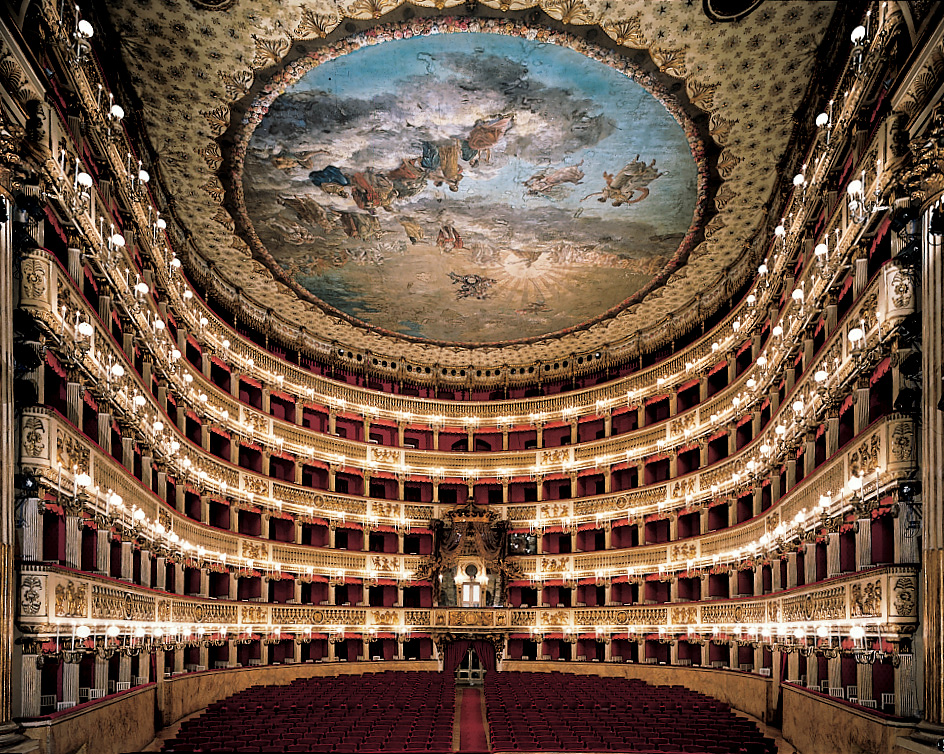The Baroque in Naples, Italy
It was the most beautiful capital in Europe. According to Goethe, Naples was a kind of paradise where everyone lived in a sort of dream-like intoxication. Some twenty years later, Stendhal wrote that Toledo street, with its palaces and carriages, was the most cheerful way of the world and that he, as a lover of the opera, wrote that the Teatro San Carlo was nicer than the Scala of Milan.
The San Carlo Theater in Naples.
Of course, I am referring to the capital of the Bourbon Kingdom of Naples (1734-1860), the arrival point for travellers on the Grand Tour, who were spellbound by the natural beauty of the city and fell in love with the joyful atmosphere that characterized it, preferring it even to the austerity of papal Rome. The washerwomen, over the hill of Vomero, sang Ο sole mio, one of the oldest Neapolitan folk songs, and danced the tarantella which, according to legend, was invented by the Graces to attract Ulysses, who was charmed by the singing of the Sirens.
It is not my intention to convince you that Naples is a fabulous place. However, despite its many problems, it is a city that the conscious traveller cannot fail to visit. I came to Naples on the occasion of the exhibition dedicated to the Neapolitan Baroque, which is located within major museums, historic buildings and churches in the city, and which covers the time span from 1606 (the year of the arrival of Caravaggio) until the mid-eighteenth century.
The interior of the church of San Gregorio Armeno, Naples - Image Credit: Giuseppe Guida.
It must be said, however, that the Baroque in Naples is seen everywhere, even without the exhibition, because it is its most representative artistic expression. On the other hand, it is difficult to find since it is hidden inside narrow and dark streets, like the ones you see in movies filmed. In any case, it is not a maze. The grid of streets rather resembles a chessboard which incorporates the urban grid of the Greek Neapolis, completely transformed following the arrival of the religious orders that have occupied entire city blocks in order to build their churches and monasteries: the Benedictines, the Dominicans, the Jesuits and Carmelite nuns. At the same time, Spanish nobles arrived in Naples in the wake of the House of Aragon, the Spanish viceroys and the Spanish branch of the Bourbons and, together with the local aristocracy, they ordered the construction of residences dominated by the Baroque style when this became fashionable.
The courtyard of the Certosa di San Martino, Naples.
Naples is full of contradictions. The disenchantment of the poor I met along the way changed into hope when they gathered, in prayer, in churches full of works of art, precious marbles, statues, silver, gilded ceilings – in short, all of the paraphernalia of the Baroque – as in the chapel of San Gennaro or in the Church of Jesus. After all, it is a city with a particularly troubled history, marked by pestilence, famine, volcanic eruptions, earthquakes... “Under the clearest sky, the most precarious soil...” wrote Goethe about Naples. This explains the spread of the litanies and the deep faith in St. Gennaro, the patron saint of Naples.
One of most beautiful libraries in the world, the Biblioteca Oratoriana dei Girolamini, Naples.
The libraries of the monasteries, filled with scrolls and richly frescoed ceilings, like that of the Girolamini, are a haven of Neapolitan culture. The courtyards of the female monasteries, such as Santa Chiara, have a mundane elegance created by clay columns and benches covered with tiles decorated with depictions of flowers, bunches of grapes, scenes of hunting, ancient myths, dances and music of the Neapolitan tradition while, in the shade of a pergola, cloistered nuns walk by, reading the sacred texts. The Neapolitans, in addition to music, continue to love their spectacular baroque. The excavations of Pompeii, which brought to light the ancient ornamental motifs, did not affect the aesthetics, as happened instead to the British of the Grand Tour.
The cloister of Santa Chiara in Naples, richly decorated with majolica tiles.
From the terrace at the Hotel Excelsior, I admire the gigantic cone of Vesuvius, silhouetted in the gulf, threatening and fascinating at the same time. The eruptions of the volcano have inspired both painters and writers, but for the Neapolitans that coexisted with the volcano every day, it served as a kind of barometer. “Today is the plume” or “now has stopped,” as observed an elderly person.
Vesuvius is in their soul and I wonder if the Gulf of Naples would continue to be considered the most beautiful in the world if Vesuvius didn’t exist. I admire the view. At the bottom, there is the picturesque port of Santa Lucia, with its guitarists and restaurants. Far in front stands the Sorrento peninsula and, even further away, in the open sea, you can see the magical silhouette of Capri.
A panoramic view of Naples with the Vesuvius in the background.
Travel with my Books in English






